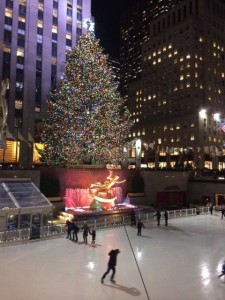
In honor of solidarity and the fact that our hearts go out to the many New Yorkers who have lost their lives in the COVID-19 pandemic, we decided to focus this month’s State of the Month on the Northeast state of New York. It was one of the original 13 colonies that formed the United States. It is the fourth most populous state and is the 27th largest. The state and city (New York City) were both named for the 17th-century Duke of York, the future King James II of England. New York City is a global city home to the United Nations Headquarters, and has been described as the cultural, financial, and media capital of the world, as well as the world’s most economically powerful city.
The state has a diverse geography. The southern part of the state is in the Atlantic Coastal Plain and includes Long Island and several smaller associated islands, as well as New York City and the lower Hudson River Valley. The large upstate New York region comprises several ranges of the Appalachian Mountains, and the Adirondack Mountains in the Northeastern Lobe of the state. The north-south Hudson River Valley and the east-west Mohawk River Valley bisect these mountain regions. Western New York is considered part of the Great Lakes Region and borders Lake Ontario, Lake Erie, and Niagra Falls. The central part of the state is dominated by the Finger Lakes, a popular vacation and tourist destination.
Business Climate
Anchored by Wall Street in the Financial District of lower Manhattan, New York City has been called the most economically powerful city and the leading financial center of the world. Lower Manhattan is the third-largest central business district in the world. New York is also the principal commercial banking center of the United States.
New York is the nation’s third-largest grape producing state, and the second largest wine producer by volume, behind California. The Southern Finger Lakes Hillsides, the Hudson Valley, the North Fork of Long Island, and the southern shore of Lake Erie are the primary grape- and wine-growing regions in New York, with many vineyards. New York is a major agricultural producer overall, ranking among the top five states for agricultural products including maple syrup, apples, cherries, cabbage, dairy products, onions, and potatoes. The state is the largest producer of cabbage in the U.S. The state has about a quarter of its land in farms. The south shore of Lake Ontario provides the right mix of soils and microclimate for many apple, cherry, plum, pear and peach orchards. Apples are also grown in the Hudson Valley and near Lake Champlain. A moderately sized saltwater commercial fishery is located along the Atlantic side of Long Island.
The state’s imports include prepared foods, computers and electronics, cut diamonds and other commodities. New York’s largest imports are oil, gold, aluminum, natural gas, electricity, rough diamonds, and lumber. The state also has a large manufacturing sector that includes printing and the production of garments, mainly in New York City, and furs, railroad equipment, automobile parts and bus line vehicles, concentrated in Upstate regions.
Tax Climate
The top individual income tax rate is approximately 8.82% and the top corporate income tax rate is 6.5%.
Apportionment: New York uses a single sales factor formula for the apportionment of corporate income taxes.
New York uses the market-based method for the sourcing of services and intangible property. Receipts from services and intangibles are based on the location of the taxpayer’s market.
Sales Tax Structure
The state sales tax rate is 4%, which ranks 40th in the nation, but the state also allows for local taxes, so the combined rate is often over 8%. New York City and environs are at 8.875%
New York has enacted economic nexus legislation. Remote sellers are required to collect the state sales tax if the company’s sales total more than $500,000 and it makes more than 100 separate transactions into the state in the immediately preceding four quarters. This legislation became enforceable on June 21, 2018, the date of the United States Supreme Court decision in South Dakota v. Wayfair.
Effective June 1, 2019, a remote marketplace facilitator who made or facilitated more than $500,000 in gross sales and 100 transactions in the state in the preceding 4 quarters is required to obtain a certificate of authority, collect sales tax, file returns, and remit tax on all sales made into the state. All in-state marketplaces are required to collect sales tax on all sales in the state.
New York is moderate in its approach to the taxation of technology products for sales tax purposes. All digital products are exempt, except for digital books, which depends upon whether it is an e-book or a taxable information service. Prewritten computer software that is electronically downloaded is taxable and custom computer software that is electronically downloaded is exempt. Lastly, SaaS is taxable. How products are produced, sold and delivered is critical to determining their tax status.
Many states have annual sales tax holidays, during which certain items the state wants to promote the purchase of (like school supplies, emergency preparedness supplies, or energy efficient appliances) can be purchased sales tax free. New York does not currently have any scheduled sales tax holidays. However, New York experimented with a retail sales tax holiday in the mid-1990s, but abandoned it in favor of a year-round exemption on clothing and footwear sold for less than $110.
Life during the COVID-19 Pandemic
As life in the state has changed and turned upside down due to the increasing number of coronavirus cases, the Department of Taxation and Finance has released a notice to abate late filing and payment penalties and interest on quarterly sales and use tax filings with a due date of March 20, 2020. The relief goes to taxpayers having difficulty in meeting all of the tax filing, payment or other deadlines because of the closure orders resulting in the outbreak. The returns must be filed, and the amount must be paid within 60 days of the due date in order to get the relief. The state however, has not yet extended the deadline for sales and use taxes.
Random Facts
- Lake Placid, New York is the only U.S. city to have hosted the Winter Olympics twice, first in 1932 and again in 1980.
- With 54,556 square miles, New York is the 27th largest state in the United States. The state of Rhode Island would fit into New York more than 35 times.
- Adirondack park in Northeast New York has 6 million acres, making it the largest park in the United States. It is larger than Yellowstone, Glacier, Everglades, and Grand Canyon National Parks combined.
- With 18,000 cattle and calf farms, New York State is the third leading producer of dairy products in the United States.
- From 1886 to 1924, over 4 million immigrants entered through New York harbor into the United States. About 40% of Americans can trace at least one ancestor to Ellis Island.
- In 1971, the bloodiest prison rebellion to ever take place in the United States happened at the Attica State Correctional Facility in Attica, New York. A total of 43 inmates and officers lost their lives during the riot.
- If the state of New York were its own country, its economy would rank 15th in the world, being slightly smaller than the economies of Canada and Spain. New York’s economy ranks 3rd in the U.S. after California and Texas.
- France gifted the Statue of Liberty to the United States in 1886 as a celebration of 100 years of U.S. independence and continued allegiance between the two countries. The statue was shipped as 350 pieces in 214 crates and took 4 months at its current home on New York’s Ellis Island.
- The New York Stock Exchange is the largest exchange in the world, with a trading volume of 5.5 million. The second largest is the NASDAQ, which is also located in New York.
- Chittenango, NY is the home of Wizard of Oz author L. Frank Baum. The town has yellow brick sidewalks that lead up to The Wizard of Oz themed businesses, such as Auntie Em’s, as well as an annual Munchkins parade.
- New York was the 11th state in the United States and was a part of the original 13 colonies. New York City was the first capital of the nation from 1789 to 1790, and George Washington was inaugurated as the first U.S. president in the city’s federal hall on Wall Street on April 30, 1789.
Our team at Miles Consulting Group is available to discuss the specifics of your state tax situation, whether in New York or other states, we can help you navigate the complex tax structures arising from your multistate operations. Call us to help you achieve the best tax efficiencies.



















